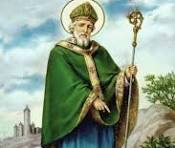
by Kevin T McEneaney
Saint Patrick’s Day was placed on the RC universal church calendar as a feast day in the early 1600’s. If Saint Patrick’s Day falls during Holy Week, it is moved for or aft, as it was in 2008 when it was moved to March 14. By the way, March 17 was the old feast day of Liber Pater, the Roman god of freedom and wine. On that day the new spring wine was opened up and riotous, lewd license triumphed. To combat this, the church declared that St. Patrick was a man who never drank, yet there is no evidence for this assertion.
Saint Patrick (a Roman nick-name meaning father of citizens) was born in Wales (373? -463?). Maewyn Succat was his birth name. His father was Church bishop who owned large tracts of land. As a young teenager he was not devout, and he once stole his father’s communion cup and performed some blasphemous act with it. At the age of sixteen he was kidnapped by Irish pirates and sold into slavery. He acquired the Irish language when he became slave-servant on the west coast of Ireland.
At twenty-two he managed to escape with a band of raiding pirates who dropped him off in Wales near his birthplace. He embraced Christianity and decided to follow in his father’s footsteps. (In those days a bishopric could be inherited.) He went to Auxerre in southern France where he learned French for his education and ordination to the priesthood where he asked to be ordained with the name Patricus. Upon returning to northern Wales, he discovered that his father had died, and he became the new bishop. He was not popular in his local community.
He decided to sail to Ireland with a band of other priests and bring Christianity to Ireland. Patrick’s sister had married into the northern Irish nobility (she lived on the Boyne river near Newgrange) which enabled Patrick to legalize Christianity in Ireland. While he was involved in various controversies with the old nobility, he refused to accept any money from the nobility. At one point a certain Irish King arrested him for treason; that King considered that preaching peace was a form of treason. He was convicted, imprisoned, and sentenced to death, but several other kings ransomed him three days before his scheduled beheading. To this day in the Our Father prayer when recited in the Irish language, they do not say deliver us from evil, but say deliver us from was because war is considered the greatest evil. The word Erin in Irish means peace (derived from the Greek eirini).
Patrick converted many people to Christianity and eventually appointed more bishops in Ireland than there were bishops in the Church, yet his attempt to reform the papacy failed due to the remote logistics of Ireland. (The election of the Pope was advanced from three months after the death of a Pope to three weeks, then to three days to prevent the northern Christian Church from voting.) Patrick left a single text, his Confessions (written in Latin), which is quite interesting.
The color blue was the color favored by the French-educated St. Patrick, but politics in the late 17th century changed that color to green. The “wearing of the green,” that is, green clothing, or a shamrock in a lapel, is in commemoration of the failed 1798 rebellion when the rebels wore green uniforms. Some of those rebels were exiled to America and formed a small Irish community in New York City, yet the first St. Patrick’s Day celebration had been held in Boston as early as 1737.
Those New York exiles were later supplemented by emigrants in the 1820s and 30s. Their presence gave rise to a nativist-bubble hysteria. Northern Irish Protestants saw southern Irish immigrants as a blight on civilization. They moved their summer Orange Day celebrations to March 17th. Since Patrick was supposedly a man of temperance, they got drunk, held drumming parades from Wall Street to Chinatown while they burnt effigies of St. Patrick and the Pope, singing anti-Catholic ditties.
In 1857, the parade eventually expanded up to the newly created Central Park where Catholics waited to battle Protestants with gentlemanly insults and fisticuffs (while horse policeman armed with Billy-clubs usually broke up the donnybrook after an hour of broken noses and black eyes), until the Civil War offered a new distraction.
As time marched on and demographics changed, Catholics took complete control of the parade, and it became a massive showcase for immigrant success in the 1940s. In 1947 the parade featured 80,000 marchers and about a million spectators. For the past six decades it has been telecast to the whole nation. The public success of the event probably helped to pave the way for the election of President JFK.
The first St. Patrick’s Day parade in Ireland was held in Dublin in 1931.
This Sunday Savannah, Georgia, will celebrate the 200th anniversary of its Saint Patrick’s Day parade.
For a contemporary Irish American short story on Saint Patrick’s Day by Thomas McGonigle see this link.